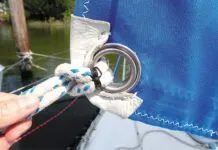I have a boat with a good amount of teak. As a lazy-er, efficient! thats the word, efficient-owner I have waited out the previous owners Bristol Finish. This product was great when new, but difficult to patch as it aged. It has finally flaked off after 10 years or so. For me, the most important characteristic for a coating is that it be easy to remove without damaging the teak, and be easily and imperceptibly patched, because coatings don’t go all at once. Also formulations change. It sounds like a mix of Cetol Natural covered by Cetol Gloss is the way to go?
Robert Luby
via PS Online
When it comes to coating wood, theres no product that will suit everyones needs. Cetol sounds like it would be a good choice for you. The trick is to stay on top of the touch-ups as needed and not let the coating go too far south before touching it up. Cetol is a softer finish than Bristol, and it will probably need an annual recoat (or less frequently, depending on where you sail).
The Cetol Natural with Cetol Marine Gloss overocoat would be a good compromise for you. Its a finishing system intended to work together, and it has shown good results in our tests. Heres a quick summary of the options.
Varnishes
One- and two-part varnishes are clear, hard coatings that show off the woods natural beauty. They come in a variety of glosses, from the classic wet look to a matte finish, which has less glare.
Pros:
- These last longer than other types, requiring less frequent application and maintenance.
- Varnishes offer a more abrasion-resistant finish.
- Varnishes create mirror-like finish enhances the woods natural grain.
- Two-part systems are regarded as being more durable than single-parts.
Cons:
- Prep and application are more labor-intensive and require a more careful hand.
- Gloss varnishes tend to show nicks and scratches more readily than low-gloss or matte finishes, and the hard barrier will blister if moisture migrates up through fastener holes.
- The hard coatings may crack or peel, requiring spot maintenance or-if not maintained well-stripping and re-applying.
- The super-hard shell makes touch-ups as tricky as repairing scratched paint.
Synthetics and Stains
Synthetics and stains come in a range of glosses, but even with an overcoat, will not achieve the wet look of a varnish. Many manufacturers have added pigments that can turn the wood red, yellow, or opaque brown.
Pros:
- Application is a breeze: They require fewer coats than varnish, dry faster, and require little or no sanding between coats.
- Some combine an oil-based bottom coat and a glossy sealer coat to offer the deep penetration of an oil and a hard varnish-like shell.
- They are more flexible than varnish.
- Their opaque nature and high solids content offer better protection from harmful UV rays than a clear varnish.
Cons:
- These softer finishes will need to be reapplied more frequently than varnish but less frequently than teak oils.
- Pigments can mask the woods natural grain.
- Teak oils and sealers
- What sets a teak oil and a teak sealer apart is the amount of solids in the product. Sealers usually have a higher percentage of solids than oils, offering better UV protection, and last longer than oils.
Pros:
- These are easy and fast to apply.
- They penetrate deep into the wood.
- The soft finish resists blistering and cracking and does not show nicks and scratches as easily as a hard coating.
- These make the most of teaks nonskid properties.
Cons:
- They do not last as long as other finishes, requiring re-application every three to four months.
- They lack the hard protection of varnish or a gloss overcoat.
- Some oils attract dirt and encourage mold and mildew growth as the coating fails.




































